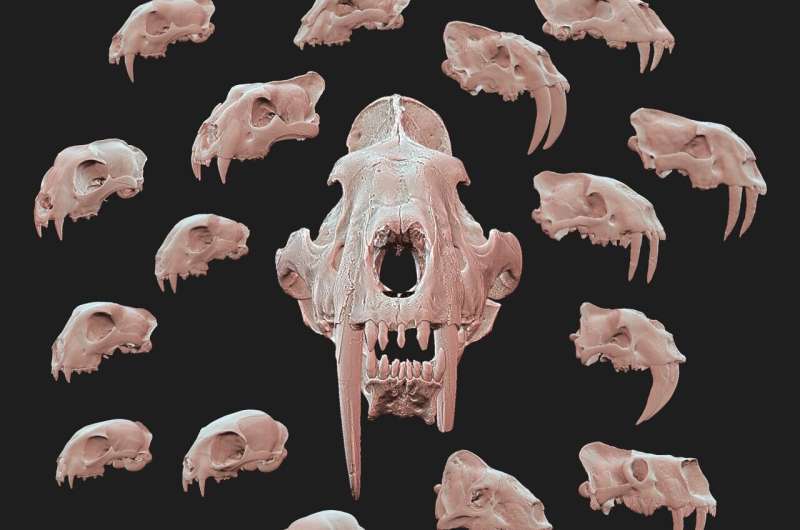
Example of the morphological variation observed in the cranium of felids and nirmavids with species exhibiting both short and long upper canines. Credit: Narimane Chatar / University of Liège
An international team led by scientists from the University of Liège has investigated the evolutionary patterns behind the development of saber teeth, with some unexpected results along the way. Their study has been published in the journal Current Biology.
Saber teeth, those iconic elongated upper canine teeth, have long fascinated both scientists and the general public, notably because they have appeared several times in the fossil record, including two particularly well-known lineages of saber-toothed tigers: the felids (the family of our domestic cats, lions, tigers, etc.) and the nimravids (a completely extinct family). However, the process by which these lineages acquired their elongated upper canines remains rather unclear.
Narimane Chatar, lead author of the study, who completed her doctorate at the EDDy Lab at the University of Liège and is now a post-doctoral fellow at UC Berkeley in the United States, has led an ambitious study to uncover the secrets of saber tooth evolution. Using state-of-the-art 3D scanners and analytical methods, the team meticulously collected and analyzed data from a diverse set of current and extinct species.
“We quantified the shape of 99 mandibles and 91 skulls, from different eras and continents, giving us a better understanding of the evolution of these animals,” explains Dr. Chatar.
“Unlocking the secrets of saber tooth evolution not only enriches our understanding of the Earth’s past, but also documents the mechanisms leading to evolutionary convergence,” says Professor Valentin Fischer, Director of the EDDyLab at ULiège.
Skull and mandible of Eusmilus sicarius, a saber-toothed nimravid scanned at Yale University Museum (Yale Paebody Museum, New Haven, U.S.). Credit: N.Chatar/Université de Liège
The study revealed some surprising results. The first is that rather than contrasting two distinct cranial morphologies in species with elongated upper canines and those with short teeth, there is instead a continuum of form linking the smallest present-day cats and their extinct saber-toothed counterparts.
“From a morphological point of view, the skull of a present-day small cat is just as strange and modified as that of a large saber-toothed felid,” says Dr. Margot Michaud, a researcher at the University of French Guyana in Cayenne. These are therefore the two extremes of a continuum of forms that feline predators have seen evolve over geological time.
“Our study suggests that what we often think of as examples of evolutionary patterns in textbooks are actually simplified for educational purposes. However, when we immerse ourselves in statistical analyses, we discover much more complex scenarios in these cases, as suggested by the results of our convergence tests,” explains Davide Tamagnini, post-doctoral researcher at the University of Rome La Sapienza.
The second surprise concerns the path taken by evolution to produce saber-toothed species. In fact, the team’s work has revealed that saber-toothed species show faster rates of morphological evolution at the start of their evolutionary history than species with shorter canines.
“Among other fascinating discoveries, we have shown that craniomandibular integration in saber-toothed species is reduced, facilitating greater adaptability and diversification in the jaw and cranial morphology,” points out Margot Michaud.
Thus, rapid morphological diversification and a fairly plastic skull have been identified as two key components that facilitated the emergence of elongated upper canines in both felids and nimravids. “As a result, there appears to be a common recipe for evolving into saber-toothed feline-like predators,” says Dr. Chatar.
Finally, the team’s research highlighted the decline of saber-toothed forms as well as the broader trends of feline-like predators over the course of their evolutionary history. Despite the relatively recent extinction of saber-toothed forms ‘only’ a few thousand years ago, feline predators have in fact been in decline since the Miocene epoch (between 23 and 5 million years ago).
“Some of these feline predators, particularly the saber-toothed species, rapidly occupied fairly specialized niches, which made them more susceptible to extinction,” explains Dr. Tamagnini.
This phenomenon, known as ‘ratchet’ or macroevolutionary ratchet, has been proposed as a potential driver for the decline of certain groups, where evolution favors the loss of early generalized forms, leading to the emergence of more specialized, but also more vulnerable, forms later in the history of the lineage.
“Predators have their own evolutionary pathways and risks of extinction. Studying how ancient predators prospered and declined provides us with information about the possible futures of our ecosystems,” concludes Professor Fischer.
More information:
Evolutionary patterns of cat-like carnivorans unveils drivers of the sabertoothed morphology, Current Biology (2024). DOI: 10.1016/j.cub.2024.04.05
Citation:
How saber-toothed tigers acquired their long upper canine teeth (2024, May 16)
retrieved 16 May 2024
from https://phys.org/news/2024-05-saber-toothed-tigers-upper-canine.html
This document is subject to copyright. Apart from any fair dealing for the purpose of private study or research, no
part may be reproduced without the written permission. The content is provided for information purposes only.
>>> Read full article>>>
Copyright for syndicated content belongs to the linked Source : Phys.org – https://phys.org/news/2024-05-saber-toothed-tigers-upper-canine.html
